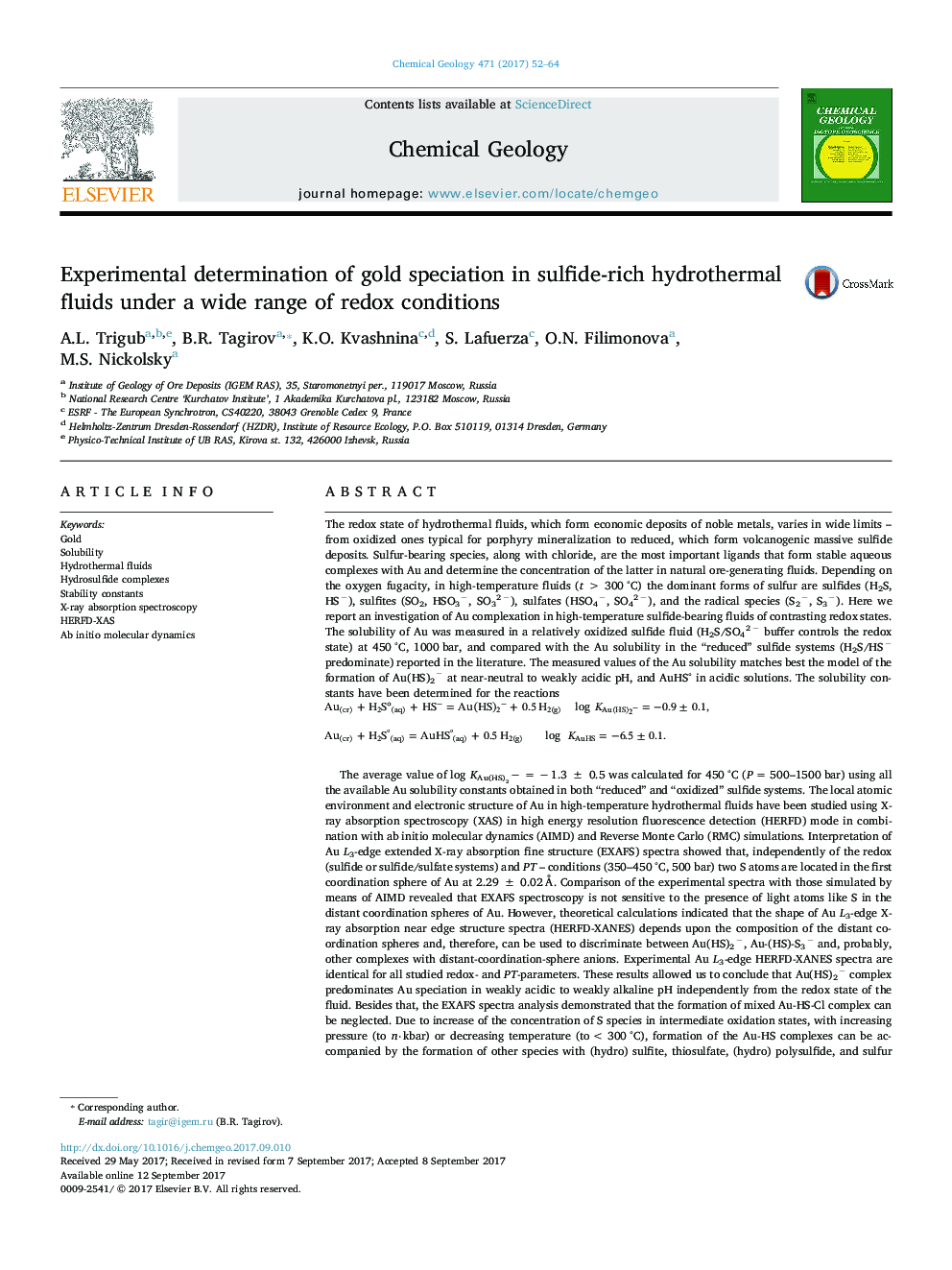| کد مقاله | کد نشریه | سال انتشار | مقاله انگلیسی | نسخه تمام متن |
|---|---|---|---|---|
| 8910544 | 1637503 | 2017 | 13 صفحه PDF | دانلود رایگان |
عنوان انگلیسی مقاله ISI
Experimental determination of gold speciation in sulfide-rich hydrothermal fluids under a wide range of redox conditions
ترجمه فارسی عنوان
تعیین تجربی ویژگی طلا در مایعات هیدروترمالی غنی از سولفید در طیف گسترده ای از شرایط بازیافت
دانلود مقاله + سفارش ترجمه
دانلود مقاله ISI انگلیسی
رایگان برای ایرانیان
کلمات کلیدی
موضوعات مرتبط
مهندسی و علوم پایه
علوم زمین و سیارات
ژئوشیمی و پترولوژی
چکیده انگلیسی
The average value of log KAu(HS)2 â = â 1.3 ± 0.5 was calculated for 450 °C (P = 500-1500 bar) using all the available Au solubility constants obtained in both “reduced” and “oxidized” sulfide systems. The local atomic environment and electronic structure of Au in high-temperature hydrothermal fluids have been studied using X-ray absorption spectroscopy (XAS) in high energy resolution fluorescence detection (HERFD) mode in combination with ab initio molecular dynamics (AIMD) and Reverse Monte Carlo (RMC) simulations. Interpretation of Au L3-edge extended X-ray absorption fine structure (EXAFS) spectra showed that, independently of the redox (sulfide or sulfide/sulfate systems) and PT - conditions (350-450 °C, 500 bar) two S atoms are located in the first coordination sphere of Au at 2.29 ± 0.02 Ã
. Comparison of the experimental spectra with those simulated by means of AIMD revealed that EXAFS spectroscopy is not sensitive to the presence of light atoms like S in the distant coordination spheres of Au. However, theoretical calculations indicated that the shape of Au L3-edge X-ray absorption near edge structure spectra (HERFD-XANES) depends upon the composition of the distant coordination spheres and, therefore, can be used to discriminate between Au(HS)2â, Au-(HS)-S3â and, probably, other complexes with distant-coordination-sphere anions. Experimental Au L3-edge HERFD-XANES spectra are identical for all studied redox- and PT-parameters. These results allowed us to conclude that Au(HS)2â complex predominates Au speciation in weakly acidic to weakly alkaline pH independently from the redox state of the fluid. Besides that, the EXAFS spectra analysis demonstrated that the formation of mixed Au-HS-Cl complex can be neglected. Due to increase of the concentration of S species in intermediate oxidation states, with increasing pressure (to n â
 kbar) or decreasing temperature (to < 300 °C), formation of the Au-HS complexes can be accompanied by the formation of other species with (hydro) sulfite, thiosulfate, (hydro) polysulfide, and sulfur radicals, which would enhance the hydrothermal Au mobility. Stability of these complexes needs further experimental and theoretical examination.
ناشر
Database: Elsevier - ScienceDirect (ساینس دایرکت)
Journal: Chemical Geology - Volume 471, 5 November 2017, Pages 52-64
Journal: Chemical Geology - Volume 471, 5 November 2017, Pages 52-64
نویسندگان
A.L. Trigub, B.R. Tagirov, K.O. Kvashnina, S. Lafuerza, O.N. Filimonova, M.S. Nickolsky,
